
| Home | Open Account | Help | 288 users online |
|
Member Login
Discussion
Media SharingHostingLibrarySite Info |
Nostalgia & History > Clark KinseyDate: 12/11/12 05:53 Clark Kinsey Author: flynn While doing a Google image search I found a terrific photo of perhaps a piece of track laying equipment.
Picture 1, The caption of Picture 1 said the photo was from the University of Washington Photo Collection 516. The writing on the picture said Schafer Brother’s Log Co. C. Kinsey Photo. 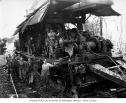 Date: 12/11/12 05:55 Re: Clark Kinsey Author: flynn I went to the University of Washington Digital Collections and tried to do various searches to find out more information about the picture but was unsuccessful.
http://content.lib.washington.edu/index.html I did a search for Kinsey Clark and found 2133 photos. I found an interesting webpage, “Clark Kinsey & the Documentation of the Pacific Northwest Logging Industry,” that gave a Biographical Sketch of Clark Kinsey and pictures. http://www.lib.washington.edu/specialcollections/collections/exhibits/Kinsey The following excerpts are from the above web page, “Clark K. Kinsey was born April 15, 1877 in Grant Township, Nodaway County, Missouri. His parents were Edmund Kinsey Sr. and Louisa McBride Kinsey. Edmund and Louisa were married February 6, 1867, in Boone County, Illinois. Clark was the youngest of six children. Alfred was born in 1868 in Illinois. Darius -- destined to be the other famous photographer in the family -- was born in 1870 in Missouri. So sometime between 1868 and 1870, Edmund moved his family to Missouri. Clarence was born in 1872, Emeline (Mrs. Burt Odell) in 1873, and Edmund Jr. in 1876. Edmund and Louisa Kinsey are believed to have purchased the first lots in the new town of Snoqualmie, Washington (later Snoqualmie Falls). They quickly became community stalwarts. The couple and their six children are widely considered Snoqualmie's ‘first family.’ ‘In the 1890s, they provided newborn Snoqualmie with a hotel, store, post office, church, meat market and community center,’ reads the inscription on a plaque commemorating the Kinsey family that hangs outside the 1923 building that housed the town's first bank. (The building was used as a city hall until a 1990 flood forced the city staff into a newer building). The Kinsey family was also responsible for building the town's first livery stable and a hall for the Good Templars, an organization that was a strong political force in the national prohibition movement. Clark, Darius, and Clarence are said to have learned photography from a Mr. Rhinehart, who came to Snoqualmie from Chicago and stayed for one year at the Kinsey Hotel. From 1894, Clark operated studios with Darius in and north of Seattle. They would travel during the summertime from place to place in small localities throughout northwestern Washington, using a large portable tent as a studio. ‘While taking pictures around Black Diamond coal mining camps in 1898, Clark met Mary Jane Williams. He was 21 and she was 16. They were married in a double wedding with Mary's sister, Sara, and Clark's brother Ed, in Black Diamond's Diller Hotel.’ (James, p. 29) Around 1899, Clark and Mary went to the Klondike. Although he engaged in mining there for several years, he was most successful with his photography business. He operated a studio with his brother Clarence in Grand Forks as well as documenting in the field the many mining and engineering projects and the scenery of the Yukon Territory. Around 1906, Clark and Mary returned to the Snoqualmie area. Clark operated a contracting firm, which he moved to Seattle in 1908. Concentrating in street and highway construction, he worked on various large projects in Seattle and King County. He eventually relocated the business to Vancouver, B.C. He also went into the chicken business in the White River valley. In 1913, however, he once again took up his camera as a professional photographer, specializing in the wood products industry, very much like his brother Darius. The two brothers were working in the same woods for a time, but they realized that this was time-wasting. So they agreed to divide up ‘the territory,’ Clark operating mostly south of the Seattle area and Darius usually to the north. ‘Clark Kinsey was a banty rooster of a man, husky for his size, 140 pounds, quick to move, agile at scrambling over logs, fearless of logging dangers and surely the most productive picture taker ever to record the deeds of men in big timber. ‘A difference in the procedures of the two brothers was their processing of negatives. Darius would send his home from camps to his wife, Tabitha, who worked in a fully-equipped darkroom in their Seattle home. Clark and Mary had no home darkroom. They traveled together into the woods, lugging along three small children and enough heavy gear to sink their Tin Lizzie touring car to the axles. ‘They carried a tent and bedding as housing where camps had no extra bunkhouses. In Grays Harbor County, which had logging camps on every creek, they would rent a house in Montesano and work out of it. Clark was in the field from March to November. In summer months, the children came along with definite duties. Their first summer, Ronald, 12, took and delivered picture orders; Doris, 6, helped her mother wash prints and looked after baby Margaret, 3. ‘Photography involves not only cameras but negative holders, chemicals for developing and 'fixing' prints, processing and washing trays, metal ferrotype plates for drying prints and heavy boxes of photographic papers. Clark worked with an 11x14-inch box camera which stood on tripod legs as high as he was. Everything was heavy and teetering. More biographical material on the above website. I decided to search all 2133 photos to see if I could find information on Picture 1. I found Picture 1. Search Number 1862. “Title: Crew with donkey engine on flatbed railroad car, Schafer Brothers Logging Company, probably in Grays Harbor County, n.d. Photographer: Kinsey, Clark. Date: n.d. Notes Caption on image: Schafer Bros. Log. Co. C. Kinsey Photo. No. 21x PH Coll 516.3636. Contextual Notes: Schafer Brothers Logging Company got its start in 1893 when brothers Peter, Albert and Hubert Schafer began logging on the family homestead 6 miles upstream from the mouth of the Satsop. They logged with oxen and horses for 20 years. The company's first donkey engine was purchased from Washington Iron Works. Hubert went to work at the factory to learn how donkey engines were made and also to have all of his wages, except for living expenses, applied toward the cost of that first donkey engine. In 1913, they bought a 45-ton Heisler locomotive and laid tracks into the woods from Brady to begin their railroad logging operation. A shingle mill was purchased in Montesano in 1919, the first of many manufacturing plants the company would own throughout Grays Harbor County. At the peak of operation, the Schafers were running one of the largest logging, milling and shipping concerns in the lumber industry of the Pacific Northwest. Their properties and equipment at that time, not counting ships and tugs, included five sawmills in operation, served by six camps sending logs over 100 miles of rail. This required 18 locomotives, both geared and mainline types, and a total of 70 donkeys and 325 logging cars. To operate all of this equipment called for approximately 3000 employees. Simpson Timber Company purchased Schafer Brothers Logging Company in 1955.” “Object Type: Photograph. Physical Description: Silver gelatin, b/w ; 11 x 14 in. Digital Reproduction Information: Scanned from a photographic print using a Microtek Scanmaker 9600XL or 9800XL at 100 ppi in grayscale. Resized using Adobe Photoshop 7.0 or 8.0 so that the long dimension was either 768 pixels horizontal or 600 pixels vertical, then saved in JPEG format at quality rating 3. 2004.” Wikipedia has a webpage on Steam Donkey http://en.wikipedia.org/wiki/Steam_donkey Below are nine photos from the above search. Picture 2, Search Number 357. “Title: Flatbed crew transport car and Heisler locomotive, Turvey Brothers Logging Company, ca. 1930. Photographer: Kinsey, Clark. Date: ca. 1930. Notes: Caption on image: Turvy Bros. Log Co. C. Kinsey Photo, Seattle. No. 16. PH Coll 516.4462. Contextual Notes: Cliff and Herbert Turvey started Turvey Brothers Logging Company in Tenino ca. 1917. The company was in business until ca. 1933, when Herbert died. Cliff and Herb Turvey were the sons of Eben N. and Flora Turvey. Cliff was born in 1888 and died in 1930. Herbert was born in 1889 and married Myrtle Evelyn Bonney in 1907. Tenino is a community a dozen miles south of Olympia in south central Thurston County. Located on a prairie Tenino was at the junction of Indian, military and civilian roads between Fort Vancouver, Fort Steilacoom and Olympia. The Indian name means ‘...fork or junction’ and probably referred to the Indian trail crossings. Other stories ascribe the name source to: (1) the figures 10-9-0 on a railroad survey stake; (2) the same numbers on a railway locomotive that once operated on the line.”  Date: 12/11/12 05:58 Re: Clark Kinsey Author: flynn Picture 3, Search Number 469. “Title: St. Paul and Tacoma Lumber Company's three-truck Shay locomotive no. 2, n.d. Photographer: Kinsey, Clark. Date: n.d. Notes: Caption on image: St. Paul & Tacoma. Kinsey Photo No. 27. PH Coll 516.3390. Contextual Notes: On June 4, 1888, the St. Paul & Tacoma Lumber Co. incorporates. The incorporators are lumber and real estate magnates who arrive that day by train from Minnesota and Wisconsin. The next day Tacoma headlines shout the event: ‘The monster milling company of Tacoma organized.’ The firm, known locally as the St. Paul, spurs what the historian Murray Morgan calls the greatest boom in Tacoma's history. Before the firm was incorporated these entrepreneurs had purchased 80,000 acres of Pierce County timberland, mostly Douglas fir, from the Northern Pacific Railroad's land grant. They had received from the Railroad a small island on the Tacoma waterfront called ‘the boot’ and had purchased other land as well. By 1889, they had built the mill, laid tracks into the forest, established camps and skidroads, and were transporting 50 carloads of logs a day into Tacoma for processing. The St. Paul & Tacoma Lumber Company was in business until 1947, when it was bought out by the St. Regis Paper Company.
This particular locomotive (sn2166) manufactured by Lima Locomotive Works by the St. Paul & Tacoma Lumber Company in 1909 from the Hofius Steel & Equipment Co. and was used first at Ohop and then at Kapowsin. It was a three-truck class C locomotive. In 1930 in was converted to an oil-burning engine. It was eventually scrapped.”  Date: 12/11/12 05:59 Re: Clark Kinsey Author: flynn Picture 4, Search Number 712. “Title: Logging crew and donkey engine on flatcar, West Fork Logging Company, Mineral, ca. 1935. Photographer: Kinsey, Clark. Date: ca. 1935. Notes: Caption on image: Murray Logging & Timber Co., Mineral, Wn. C. Kinsey Photo. No. 12x. PH Coll 516.2147. Contextual Notes: L.T. Murray moved the operations of his West Fork Logging Company to Mineral in 1927. He bought out the Mineral Lake Lumber Company at that time and set about creating a model permanent logging camp. He remodeled old buildings and built new ones and established lawns and flower beds and a yearly painting schedule. He provided steam heated railroad cars to take his crews to and from the logging sites and had a hot lunch taken out to the crews each day. St. Regis Paper Company bought out the West Fork Logging Company's operation in Mineral in 1943.
Mineral is a small logging and shingle mill village on Mineral Lake, 14 miles north of Morton in north central Lewis County. Once it had several producing mines, the ore from which was used for production of arsenic. It was named for mineral deposits along Mineral Creek, and producing mines a half dozen miles from the town.” 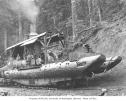 Date: 12/11/12 06:01 Re: Clark Kinsey Author: flynn Picture 5, Search Number 763. “Title: Logging crew on flat car pulled by Mud Bay Logging Company's Baldwin 2-6-2TT locomotive no. 3, n.d. Photographer: Kinsey, Clark. Date: n.d. Notes: Caption on image: Mud Bay Logging Co., Olympia, Wash. No. 16. PH Coll 516.2075. Contextual Notes: In 1899, Mark Draham, founder of the Mason County Logging Company, left that company and incorporated Western Washington Logging Company. This company, in turn, evolved into the Mud Bay Logging Company in 1910. Mud Bay Logging Company operated in the area west of Olympia until 1941.
Mud Bay is a bay at the head of Eld Inlet four miles west of Olympia in northwest Thurston County. Oyster beds in the bay once produced the famous Olympia oysters. At low tides the name is very descriptive.” 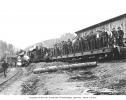 Date: 12/11/12 06:03 Re: Clark Kinsey Author: flynn Picture 6, Search Number 962. “Title Loggers and mess hall crew at railroad logging camp, Copalis Lumber Company, near Carlisle, ca. 1918. Photographer: Kinsey, Clark. Date: ca. 1918. Notes: Caption on image: Copalis Lumber Co., Carlisle, Wash. C. Kinsey Photo, Seattle. No. 57. PH Coll 516.818. Contextual Notes: The Copalis Lumber Company was in business in Carlisle from 1914 to 1920. It's logging railroad was absorbed into the Carlisle Lumber Company.
Carlisle is a small settlement on the Copalis River four miles east of the Pacific Ocean in southwest Grays Harbor County. When established in 1912 by the Carlisle Lumber Company, it was a busy logging and sawmill center. It continued to be active until the company's timber supply was exhausted. It was named for the lumber company, which originated from Wisconsin and was founded by William Carlisle.”  Date: 12/11/12 06:04 Re: Clark Kinsey Author: flynn Picture 7, Search Number 1797. “Title Construction crew with pile driver on railroad trestle under construction, camp 8, Schafer Brothers Logging Company, Brady, n.d. Photographer: Kinsey, Clark. Date n.d. Notes: Caption on image: Shafer Bros. Logging Co., Camp 8, Brady, Wash. C. Kinsey Photo, Seattle. No. 13 PH Coll 516.3664. Contextual Notes: Schafer Brothers Logging Company got its start in 1893 when brothers Peter, Albert and Hubert Schafer began logging on the family homestead 6 miles upstream from the mouth of the Satsop. They logged with oxen and horses for 20 years. The company's first donkey engine was purchased from Washington Iron Works. Hubert went to work at the factory to learn how donkey engines were made and also to have all of his wages, except for living expenses, applied toward the cost of that first donkey engine. In 1913, they bought a 45-ton Heisler locomotive and laid tracks into the woods from Brady to begin their railroad logging operation. A shingle mill was purchased in Montesano in 1919, the first of many manufacturing plants the company would own throughout Grays Harbor County. At the peak of operation, the Schafers were running one of the largest logging, milling and shipping concerns in the lumber industry of the Pacific Northwest. Their properties and equipment at that time, not counting ships and tugs, included five sawmills in operation, served by six camps sending logs over 100 miles of rail. This required 18 locomotives, both geared and mainline types, and a total of 70 donkeys and 325 logging cars. To operate all of this equipment called for approximately 3000 employees. Simpson Timber Company purchased Schafer Brothers Logging Company in 1955.
Brady is a farming community, formerly a logging town, is 4 miles northeast of Montesano in southeast Grays Harbor County. In 1917, the name was given by Northern Pacific Railway officials. It was for Emily Brady, from whom the railway acquired a right-of-way. Earlier names were Woods Crossing and Juno.” 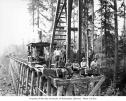 Date: 12/11/12 06:06 Re: Clark Kinsey Author: flynn Picture 8, Search Number 1898. “Title Loggers and mess hall crew at camp 4, with Schafer Brothers Logging Company's two-truck Heisler locomotive no. 1 in background, probably in Grays Harbor County, n.d. Photographer: Kinsey, Clark. Date: n.d. Notes: Caption on image: Camp 4, Schafer Logging Co. No. 3. PH Coll 516.3837. Contextual Notes: Schafer Brothers Logging Company got its start in 1893 when brothers Peter, Albert and Hubert Schafer began logging on the family homestead 6 miles upstream from the mouth of the Satsop. They logged with oxen and horses for 20 years. The company's first donkey engine was purchased from Washington Iron Works. Hubert went to work at the factory to learn how donkey engines were made and also to have all of his wages, except for living expenses, applied toward the cost of that first donkey engine. In 1913, they bought a 45-ton Heisler locomotive and laid tracks into the woods from Brady to begin their railroad logging operation. A shingle mill was purchased in Montesano in 1919, the first of many manufacturing plants the company would own throughout Grays Harbor County. At the peak of operation, the Schafers were running one of the largest logging, milling and shipping concerns in the lumber industry of the Pacific Northwest. Their properties and equipment at that time, not counting ships and tugs, included five sawmills in operation, served by six camps sending logs over 100 miles of rail. This required 18 locomotives, both geared and mainline types, and a total of 70 donkeys and 325 logging cars. To operate all of this equipment called for approximately 3000 employees. Simpson Timber Company purchased Schafer Brothers Logging Company in 1955.”
 Date: 12/11/12 06:08 Re: Clark Kinsey Author: flynn Picture 9, Search Number 2106. “Title Crew with Weyerhaeuser Timber Company's Baldwin Mallet locomotive no. 6 on trestle with log train, Melbourne, ca. 1941. Photographer: Kinsey, Clark. Date: ca. 1941. Notes: Caption on image: W.T. Co., Melbourne. Kinsey Photo No. 1. PH Coll 516.4880. Contextual Notes: At the end of the nineteenth century, Frederick Weyerhaeuser headed a Midwestern timber concern that was said to be the largest lumber business in the country. By this time, most of the old growth forests in the Great Lakes area were logged. Weyerhaeuser needed more trees to harvest and looked to the Southern and Western states. In 1891, while investigating the two regions, he moved to St. Paul and two years later moved to Summit Street next door to an old time St. Paul resident, James J. Hill. James J. Hill, President of the Great Northern Railway, was just completing the railroad from St. Paul to Seattle. Weyerhaeuser and Hill became good friends, and they occasionally discussed the Pacific Northwest. By 1900 James Hill had gained the controlling interest in the Northern Pacific Railroad, the major competitor of the Great Northern in Washington. With the purchase of the railroad company came the remnants of the 44,000,000 acres (68,750 square miles) of land the Northern Pacific once owned along its railroad route from Lake Superior to Puget Sound. The Northern Pacific had received this land from the federal government in the 1870s and early 1880s for constructing the transcontinental railroad. One evening the conversation between Hill and Weyerhaeuser turned to timberlands in Washington owned by the Northern Pacific. The conversation became negotiation because Weyerhaeuser needed trees and Hill needed cash. Nothing much is known about the negotiations except that it was claimed that Weyerhaeuser made an offer of $5 an acre for 900,000 acres of land ($4,500,000) and Hill put a price of $7 an acre ($6,300,000). They arrived at an agreed price of $6 an acre ($5,400,00). The agreement was $3,000,000 down and eight semiannual payments of $300,000 plus interest. The down payment strained Weyerhaeuser's finances and stretched his capacity to raise money to the utmost. On January 3, 1900, the papers were signed and the property was transferred to Weyerhaeuser. This was one of the largest single land transfers in American history. As part of the agreement, Hill gave Weyerhaeuser extremely low rates for eastbound shipping for timber. No one knew how much timber there was and many thought the purchase was quite speculative. The purchase turned out to be exceedingly cheap. Twelve years later, it was determined that Weyerhaeuser had paid only 10 cents per 1000 board feet (one board foot is 2 inches by 6 inches by 12 inches). Shortly after the purchase, Weyerhaeuser and other investors formed the Weyerhaeuser Timber Company. Weyerhaeuser continued to purchase timberland in Washington and by 1903 the company's holdings had increased by 67 percent to 1,500,000 acres. Although the company established a sawmill in Everett in 1903, manufacturing lumber was a secondary activity until 1915. From 1900 to 1915 the firm managed its holdings, sold timber to other sawmills, and purchased more timberland.
This particular locomotive (s/n 57601) was built in 1924 for the Clemons Logging Company. It was acquired by Weyerhaeuser in 1936. It was scrapped after 1952.” 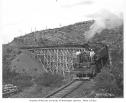 Date: 12/11/12 06:10 Re: Clark Kinsey Author: flynn Picture 10, Search Number 2120. Title: Clark Kinsey with his photographic equipment outside of tent, location unknown, n.d. Photographer Unknown. Date: n.d. Notes: The woman in this photograph may be his wife, Mary. Filed in Portraits--Kinsey, Clark. Contextual Notes: Kinsey, Clark (1877-1956): Born in Missouri and raised near Snoqualmie, Washington Territory. He first practiced photography in the early 1890s with his brothers Darius and Clarence. From 1894 he operated studios in and north of Seattle with his brother Darius. They would travel during the summertime from place to place in small localities throughout northwestern Washington, using a large portable tent as a studio. The partnership eventually dissolved, and in 1897 Clark Kinsey went to the Klondike. Although he engaged in mining for several years in this place, he was most successful with photography, having a studio as well as documenting in the field the many mining and engineering projects and the scenery of the Yukon Territory. About 1906 Clark returned to the Snoqualmie area to operate a contracting firm, which he moved to Seattle in 1908. Concentrating on street and highway construction, he attended to various large projects in Seattle and King County, eventually relocating his firm to Vancouver, B.C. In 1913, however, he once again took up his camera as a professional photographer, specializing in the wood products industry, very much like his brother Darius. Together they divided the territory, Clark operating mostly south of the Seattle area and Darius usually the north. Clark's career continued for more than thirty years, producing more than 50,000 image of logging camps, milling operations, equipment and crews. During World War I, he thoroughly documented the Spruce Division camps in Washington and Oregon and, in like manner, the Depression era's Civilian Conservation Corps some years later. His commercial success stemmed from a liberal patronage by the lumber company management and by the endorsement of the WestCoast Lumberman's Association. His access secured to private company properties, he exposed his plates and developed them virtually in the field, in temporary darkrooms or tents. He was thus able to offer instant service, a feature not characteristic of most photographers of his time. Clark Kinsey retired from active work in 1945.”
 Date: 12/11/12 06:25 Re: Clark Kinsey Author: WrongWayMurphy Wow Flynn, you found some real gems there. Love the first photo in the derrick.
Date: 12/11/12 07:05 Re: Clark Kinsey Author: santafe199 I really admire how these people who have been gone for decades seem to come alive again in your threads. The look on the faces of the operator & his helper
in image #1 speaks volumes about them in relation to their jobs. Very well presented! Lance Date: 12/11/12 08:17 Re: Clark Kinsey Author: patd3985 WOW! Thanx Flynn! You're up in my "neck-o-the woods" on these! Hell, I was walking in my backyard in Lofall, WA a few years ago and dug up an old brake shoe off of one of the many logging trains that were scattered around here years ago. Where I live now, I've got old growth stumps still 4 or 5 feet in diameter in my back yard, even though they're half rotten! God, those trees were big back then and so were the men who logged them!
Date: 12/11/12 09:56 Re: Clark Kinsey Author: YG Every image is very interesting, not only the main subject but the details, faces, and little things in the background. Wonderful post!
Steve Mitchell http://www.yardgoatimages.com Date: 12/11/12 10:23 Re: Clark Kinsey Author: fehorse1 Photo #1 is not a track machine but a Willamette built "unit" skidder logging machine. Schafer Bros. ended up owning 5 of these big machines in the 1920's. Look for my upcoming book on gthe history of Schafer Bros.
patd 3985, the brakeshoe you fopund is probably from the Moe Bros. Log Co. They logged your area c.1910 with a Climax loco. I'd be interested in knowing where you live on a map as I'm helping someone map their rail system Thanks, Pete Replinger Shelton, WA Date: 12/11/12 17:43 Re: Clark Kinsey Author: DNRY122 That first machine looks like an OSHA inspector's worst nightmare! That is one impressive piece of mechanical engineering.
Date: 12/11/12 19:11 Re: Clark Kinsey Author: lwilton fehorse1 Wrote:
------------------------------------------------------- > Photo #1 is not a track machine but a Willamette > built "unit" skidder logging machine. There was a recent thread or two on the Lidgerman Skidder. It is worth searching outfor a more full-size picture of a skidder. There is some small amount of informaiton on the web about skidders and how they were used. The picture is of about half of the skidder. The other really important part was a tower of some kind, probably around 50-70' high. This may have been an uncut tree, a re-erected tree, or in the case of the Lidgerman, it had a metal tower that was erected with the help of one of the hoist motors shown in the picture. Skidders were used to get the logs from where they were cut to the tracks to be loaded onto log cars. If you think about it, the logging company would lay a track thru the woods, and could easily cut trees within an few feet of the tracks and get them to the line. But as you got farther fromthe tracks getting the logs back to the tracks got harder. Mule teams to drag the cut log was one method. The skidder method was mroe efficient. You set up the skidder beside or over the tracks, with a tall pole next to it. The winch line ran up to the top of the pole, and then to another pole (tree) some hundreds of feet away, around a pully, and back to the home tree. You could use the winches to drag a carrier between the two trees. When a tree was cut, it only needed to be got to the line out into the woods, where a sling could be hooked onto the carrier, and the winch on the skidder would drag the log back to the home tree. At that point a second winch would help lift the log and drop it onto a log car on the railway. A skidder could have several lines going in various directions from the home tree, and the lines would be moved when the sector on both sides of the line had been completely logged. This way you could log a circle a couple hundred yards in diameter aroudn the skidder befor pulling up stakes and moving a few hundred yards down the line to a new spot. |